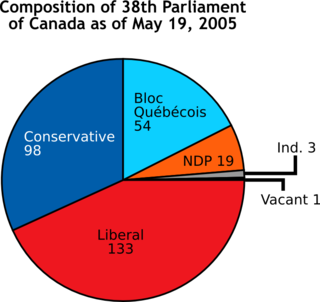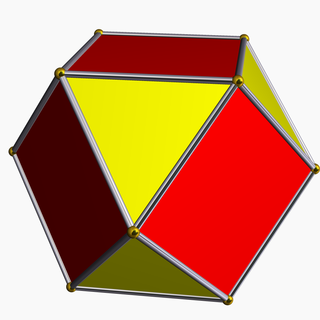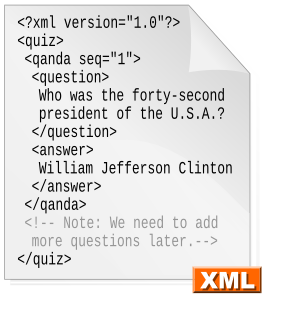The Resource Description Framework (RDF) is a family of World Wide Web Consortium (W3C) specifications originally designed as a metadata data model. It has come to be used as a general method for conceptual description or modeling of information that is implemented in web resources, using a variety of syntax notations and data serialization formats. It is also used in knowledge management applications.

In computing, s-expressions, sexprs or sexps are a notation for nested list (tree-structured) data, invented for and popularized by the programming language Lisp, which uses them for source code as well as data. In the usual parenthesized syntax of Lisp, an s-expression is classically defined as
- an atom, or
- an expression of the form
(x. y) where x and y are s-expressions.

A chart is a graphical representation of data, in which "the data is represented by symbols, such as bars in a bar chart, lines in a line chart, or slices in a pie chart". A chart can represent tabular numeric data, functions or some kinds of qualitative structure and provides different info.
Portable Game Notation (PGN) is a plain text computer-processible format for recording chess games, supported by many chess programs.
Combinatorics is a branch of mathematics concerning the study of finite or countable discrete structures.

A bar chart or bar graph is a chart or graph that presents categorical data with rectangular bars with heights or lengths proportional to the values that they represent. The bars can be plotted vertically or horizontally. A vertical bar chart is sometimes called a line graph.

A scientific calculator is a type of electronic calculator, usually but not always handheld, designed to calculate problems in science, engineering, and mathematics. They have almost completely replaced slide rules in traditional applications, and are widely used in both education and professional settings.
XDI is a semantic data interchange format and protocol under development by the OASIS XDI Technical Committee. The name comes from the addressable graph model XDI uses: every node in the XDI graph is its own RDF graph that is uniquely addressable.
A data-flow diagram (DFD) is a way of representing a flow of a data of a process or a system. The DFD also provides information about the outputs and inputs of each entity and the process itself. A data-flow diagram has no control flow, there are no decision rules and no loops. Specific operations based on the data can be represented by a flowchart.

In Euclidean geometry, rectification or complete-truncation is the process of truncating a polytope by marking the midpoints of all its edges, and cutting off its vertices at those points. The resulting polytope will be bounded by vertex figure facets and the rectified facets of the original polytope.
Common Logic (CL) is a framework for a family of logic languages, based on first-order logic, intended to facilitate the exchange and transmission of knowledge in computer-based systems.
Terse RDF Triple Language (Turtle) is a syntax and file format for expressing data in the Resource Description Framework (RDF) data model. Turtle syntax is similar to that of SPARQL, an RDF query language.

EXPRESS is a standard data modeling language for product data. EXPRESS is formalized in the ISO Standard for the Exchange of Product model STEP, and standardized as ISO 10303-11.

Diagrammatic reasoning is reasoning by means of visual representations. The study of diagrammatic reasoning is about the understanding of concepts and ideas, visualized with the use of diagrams and imagery instead of by linguistic or algebraic means.
N-Triples is a format for storing and transmitting data. It is a line-based, plain text serialisation format for RDF graphs, and a subset of the Turtle format. N-Triples should not be confused with Notation3 which is a superset of Turtle. N-Triples was primarily developed by Dave Beckett at the University of Bristol and Art Barstow at the World Wide Web Consortium (W3C).

Overture is a music notation (scorewriter) program for Windows and Macintosh platforms, written by Don Williams. Visually, the Overture scoring interface resembles Encore, another notation program originally by the same author. Overture was the first scorewriter to feature full Virtual Studio Technology (VST) hosting; the software supports MIDI and audio playback.

In combinatorial mathematics, LCF notation or LCF code is a notation devised by Joshua Lederberg, and extended by H. S. M. Coxeter and Robert Frucht, for the representation of cubic graphs that contain a Hamiltonian cycle. The cycle itself includes two out of the three adjacencies for each vertex, and the LCF notation specifies how far along the cycle each vertex's third neighbor is. A single graph may have multiple different representations in LCF notation.
In computer science, a program dependence graph (PDG) is a representation, using graph notation, that makes data dependencies and control dependencies explicit. These dependencies are used during dependence analysis in optimizing compilers to make transformations so that multiple cores are used, and parallelism is improved.
ArangoDB is a free and open-source native multi-model database system developed by ArangoDB GmbH. The database system supports three data models with one database core and a unified query language AQL. The query language is declarative and allows the combination of different data access patterns in a single query. ArangoDB is a NoSQL database system but AQL is similar in many ways to SQL.
A semantic triple, or simply triple, is the atomic data entity in the Resource Description Framework (RDF) data model. As its name indicates, a triple is a set of three entities that codifies a statement about semantic data in the form of subject–predicate–object expressions.











